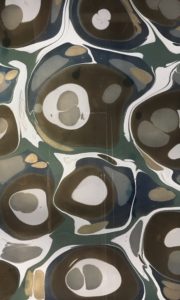 A prime concern of many marblers are the size of paint drops on the vat. They are warned that if the drops are too big they will get big areas on their papers where the pattern is all one color and you really can’t see it well. Marblers are told to keep dropping paint until the drops are only the size of a quarter. So, the drops should look like the picture just to the right. These two guidelines are helpful but they don’t get at how to achieve them.
A prime concern of many marblers are the size of paint drops on the vat. They are warned that if the drops are too big they will get big areas on their papers where the pattern is all one color and you really can’t see it well. Marblers are told to keep dropping paint until the drops are only the size of a quarter. So, the drops should look like the picture just to the right. These two guidelines are helpful but they don’t get at how to achieve them.
When I first started marbling my answer was to find a color that seemed to consistently give me small drops on any given day and save it till last. That worked most of the time but gave me very little control over what would be the last color on my papers. Over time, I have learned how to better manage the laying down of the color.
The marblers major tool in managing aggression is the rule that, once you have the paint mixed (I suggest you use a quarter sized amount of paint with about 1.5 oz water), if you want your drops to spread more (i.e., be more aggressive) you add paint and if you want your drops to spread less you add water. Note that this is just the opposite of what your “common sense” would suggest; that’s and easy way to remember what to do.
But the marblers life is not that easy! There are other factors that must be considered:
The amount of aggression in the drops of any color are also effected by when you put them on the vat. In the first rounds of dropping colors, the drops spread out more, then as increasing amounts of paint are on the surface of the vat, the drops have less space to spread so they get a little smaller.
Another factor affecting spread/aggression is the nature of the pigment itself and how it compares to the pigments that it is touching on the surface of the vat. Sometimes if your last round of color is very aggressive, you can break up the color by dropping another color in the drops of those big drops.
So how do I juggle all this when I’m marbling? I try to see how each color is reacting on the size for that day by doing a couple of sheets. As I work, I weigh how the color behaves as one of the first rounds and also as one of the last rounds. Only then do I start adding water or paint. And I only add a little of either at any one time and test how the paint works before adding more.
While this sounds really complicated, pretty soon it becomes almost second nature. Also, if I want to use a color that is aggressive towards the end and get big drops, I then add other colors that I have already dropped inside the bigger drops to break up the color. In the picture with this post, the black paint was very aggressive because I added pigment and did not respond well to having more water added so I added drops of white, blue, and green inside those big black drops to break up the color (or lack thereof!).

